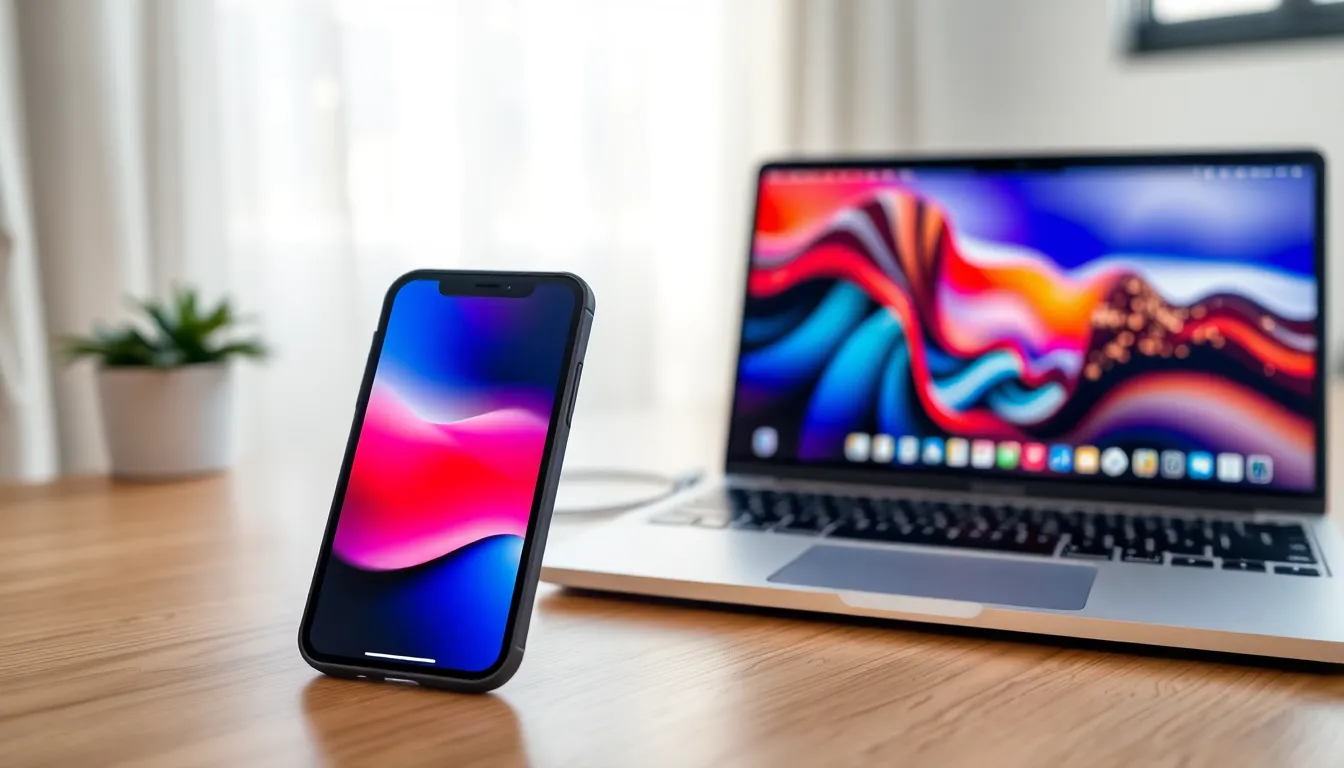Transferring photos from an iPhone to a Mac can feel like trying to solve a Rubik’s Cube blindfolded. But fear not! With a few simple steps, you’ll be importing your favorite memories faster than you can say “Where did I put my phone?” Whether you’re looking to free up space on your device or simply want to bask in the glory of your vacation snaps on a bigger screen, this guide will make the process a breeze.
Table of Contents
ToggleUnderstanding the Basics of Photo Importing
Importing photos from an iPhone to a Mac involves recognizing several key aspects. First, understanding the connection methods plays a crucial role. Users can connect their iPhone via USB cable or use wireless options like AirDrop or iCloud.
The Photos app acts as the primary tool for managing image imports. When the iPhone connects, the app launches automatically, displaying import options. Users can select specific photos or choose to import all images.
It’s important to note file formats and storage locations. JPEG and HEIC formats commonly store photos on iPhones. Users should ensure the Mac supports these formats when importing. Likewise, knowing where imported images are saved on the Mac helps in organizing photo libraries efficiently.
Familiarity with system requirements enhances the import experience. Ensuring that both devices run the latest software versions can prevent compatibility issues. Users also benefit from troubleshooting basics, such as restarting devices or checking connections when problems arise.
Understanding privacy settings is essential. Users must authorize the Mac to access the iPhone’s photos. A prompt appears on the iPhone to grant permission, necessary for a successful transfer.
Learning these basics improves the importing process and minimizes frustrations. Each step counts, from connecting devices to selecting photos, leading to effective and organized storage.
Preparing Your Devices

Preparing devices for photo import contributes to a smoother experience. Users must ensure both the iPhone and Mac are ready for the transfer process.
Ensuring Your iPhone Is Updated
Updates to the iPhone’s software enhance its functionality and compatibility. Navigate to Settings, then General, and select Software Update to check for any available updates. By keeping the device current, users minimize the risk of issues during the import process. Confirming the iPhone runs iOS 14 or later ensures optimal performance when transferring photos.
Checking Mac Compatibility
Compatibility between the Mac and iPhone is essential for a successful transfer. Verify the Mac has the latest version of macOS, preferably macOS Mojave or later. To check the software version, click the Apple menu, select About This Mac, and review the displayed system information. Ensuring that both devices support the latest applications enhances the user experience and prevents interruptions during the photo import process.
Importing Photos Using the Photos App
Importing photos from an iPhone to a Mac is straightforward when using the Photos app. Follow these steps to ensure a seamless transfer.
Connecting Your iPhone to Mac
First, connect your iPhone to the Mac using a USB cable. Ensure the cable is functional and connected securely to both devices. When connected, the Photos app should automatically launch. If it doesn’t, open the app manually. Trust the Mac on your iPhone when prompted, allowing access to photos. Verifying that both devices are updated enhances compatibility during this process.
Selecting Photos for Import
The Photos app displays all recent images stored on the iPhone. Users can either select specific photos or opt to import all images displayed. Checking individual photos allows control over which images to bring to the Mac. Use the selection checkbox next to each photo for this purpose. Explore thumbnails to view details about each image before selecting. This step ensures that only desired photos occupy storage on the Mac.
Finalizing the Import Process
After selecting photos, click the import button located at the top right corner. Users can choose to delete imported photos from the iPhone after the transfer is complete. This helps in managing storage space on the iPhone effectively. As the import progresses, a status bar will indicate completion. Once finished, safely disconnect the iPhone from the Mac to avoid data loss. Enjoy the newly imported photos organized in the Photos app for easy access and viewing.
Alternative Methods for Importing Photos
Several alternative methods exist for importing photos from an iPhone to a Mac. Each method caters to different user preferences and connectivity options.
Using Image Capture
Image Capture offers a straightforward way to transfer photos. First, connect the iPhone to the Mac using a USB cable. Open the Image Capture application. Select the iPhone from the list of devices shown in the sidebar. Users can see thumbnails of the images available for import. Options to choose specific photos or import all images are readily available. Simply click the “Import” button after making selections. Users can also choose a specific folder for saving these images. This method works well for those who prefer more control over their photo transfers.
Transferring via AirDrop
AirDrop provides a wireless option for transferring photos effortlessly. Ensure both devices have Wi-Fi and Bluetooth enabled. Select photos on the iPhone, then tap the Share icon. Users can choose the Mac from the AirDrop section that appears. The Mac will prompt an acceptance request. Once accepted, the transfer begins, and files will save directly to the Downloads folder on the Mac. Tips for enhancing AirDrop include staying within a close range to improve transfer speed and ensure successful connections. This method works best for quick transfers without physical connections.
Troubleshooting Common Issues
Users may encounter issues during the import process. Addressing these problems promptly enhances the overall experience.
Connection Problems
Connection problems often occur when the devices aren’t properly linked. Ensure the USB cable is functional and securely connected to both the iPhone and Mac. If a wireless connection is preferred, verifying that both devices have Wi-Fi and Bluetooth enabled is essential. Users might need to restart their devices if the connection fails. Trust prompts also require attention. Whenever an iPhone connects to a Mac, it asks for permission to allow access. Ignoring this prompt could impede photo importation.
Import Errors
Import errors can arise due to various factors. Users must check the iOS and macOS versions for compatibility. Outdated software often leads to unexpected issues. When photos appear grayed out or fail to import, it signals potential format incompatibility. Ensure images are in supported formats like JPEG or PNG. Permission settings may also block access to specific photos. Verifying that iPhone privacy settings allow the Mac to access photos often resolves these issues. Users can consult Apple’s support resources for additional guidance on resolving persistent errors.
Transferring photos from an iPhone to a Mac doesn’t have to be a daunting task. With the right preparation and knowledge of the available methods users can effortlessly import their cherished memories. Whether opting for the Photos app or exploring alternatives like Image Capture or AirDrop each method offers unique advantages tailored to individual preferences.
By ensuring both devices are updated and following the outlined steps users can avoid common pitfalls and enjoy a seamless transfer experience. With their photos safely stored on the Mac users can now relive their favorite moments on a larger screen and free up valuable space on their iPhone. Embracing these simple techniques will make photo management a breeze.




